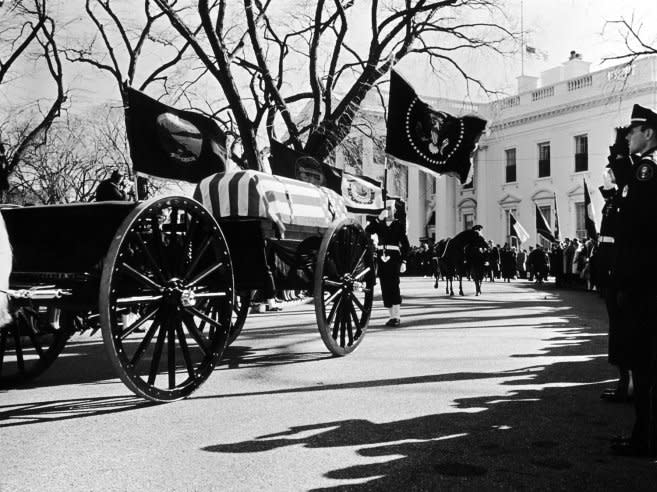 Jacqueline Kennedy once famously wrote that her aim was to be the “art director of the twentieth century.” Little did she know that some of the most enduring images she would help create would come from her husband’s funeral ceremonies after John F. Kennedy was assassinated in 1963. These images were so striking that they are etched in people’s minds as vividly today as they were 50 years ago. Those who have only seen photographs—many who weren’t born yet--feel as though they witnessed the proceedings: Black Jack the riderless horse with boots positioned backwards in the stirrups; six white horses pulling the caisson upon which the President’s flag-draped casket rested; John, Jr., donned in blue coat and shorts on his third birthday, saluting his father’s casket on its way to burial.
Jacqueline Kennedy once famously wrote that her aim was to be the “art director of the twentieth century.” Little did she know that some of the most enduring images she would help create would come from her husband’s funeral ceremonies after John F. Kennedy was assassinated in 1963. These images were so striking that they are etched in people’s minds as vividly today as they were 50 years ago. Those who have only seen photographs—many who weren’t born yet--feel as though they witnessed the proceedings: Black Jack the riderless horse with boots positioned backwards in the stirrups; six white horses pulling the caisson upon which the President’s flag-draped casket rested; John, Jr., donned in blue coat and shorts on his third birthday, saluting his father’s casket on its way to burial.
Mrs. Kennedy wanted to send a clear message to the world that her husband deserved to be remembered. She wanted people to come together to grieve a lost life. Drawing upon her art background, she recognized that people would be more likely to follow a path of healing and remember the President longer if visual images relating to his death stayed with them.
Countless educational presenters preach the need to morph the traditional funeral into a more personal ceremony. Perhaps it’s not so much the lack of personalization, but rather, the lack of memorable imagery that has become our Achilles heel. Unless we take away meaningful impressions funeral rites, how likely is it that people will see funerals as anything more than a formality, or even worse, as a burden to get through as quickly as possible?
Having said that, use of imagery to create ways to surprise mourners--to jolt them into focusing on the present--for the purpose of joining others in paying tribute to loved ones by itself isn’t quite enough. Thomas Lynch and Thomas Long recently defined “The Good Funeral” as one which strikes a balance between the “extrinsic” (caskets, memorial tributes, flowers) and the “intrinsic” (feeling loss, acknowledging grief, remembering a life) value of funerals. Mr. Lynch said that surrounding a casket while blowing bubbles is okay for an extrinsic expression of grief (that is, if bubbles held significant meaning for the deceased), but a meaningful and regenerative funeral must deal with mourners’ deep emotions. In the case of JFK’s funeral, the riderless horse not only created a vivid image, but also brought a deep feeling of loss to the surface for millions. John, Jr.’s salute is an indelible image, but more importantly, it drew attention to the fact that a young boy had lost his father.
Like all challenging problems, reversing public opinion about the declining value of traditional funerals has no simple course of action. Imagery is one part of the mix. So are ritual, connection to the deceased, and a dozen other elements that funeral professionals are experts at providing. It would be a lot easier if Black Jack the horse alone could take us across the finish line.

